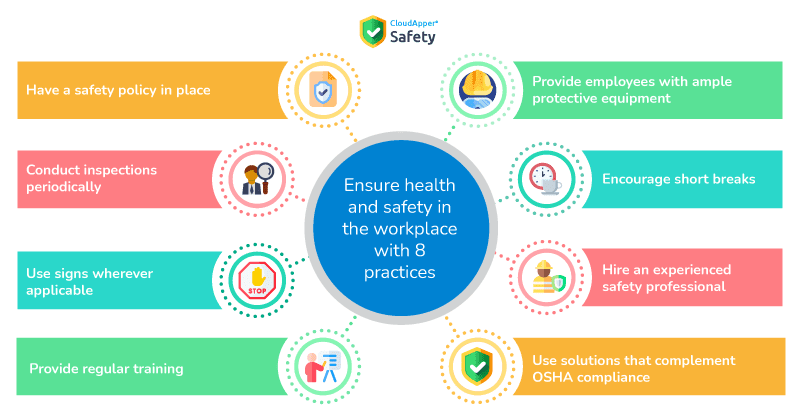Table of Contents
While most organizations usually focus on how to reduce costs while increasing profit margins, they forget a crucial piece that makes or breaks their bottom lines – their employees. Without their workers, organizations cannot operate efficiently, and to ensure that everything is running smoothly, organizations have to continuously improve health and safety in the workplace. There are many organizations, scenarios, and workplaces where risks are part of the job. For instance, in mining, construction, chemical, and transportation industries, there are quite a few safety risks present for the workers, and to offset them, employers must provide appropriate safety equipment and training.
That being said, let’s explore health and safety in the workplace, why it is so crucial nowadays, what hazards might be detrimental to worker safety, and how to improve workplace safety with 8 best practices.
What is health and safety in the workplace?
The concept is as straightforward and as easy as it sounds, even though enforcing it is a significant challenge for many companies. An employer that promotes health and safety in their premises means they focus on employee wellbeing and strive to reduce or eliminate injuries or illnesses at work. Even if there are challenging working conditions, the employer that focuses on workplace safety will provide ample protective materials to their employees in order to prevent any injuries or illnesses on the job. As can be understood, it is mostly the employer’s responsibility. But why is it so important, and what will happen if an employer doesn’t focus on workplace safety?
Well, those employers who don’t focus on workplace safety:
- Are significantly behind the competition
- Face workplace injuries more frequently
- Face employee turnover
- Face administrative costs
- Face OSHA violations and heavy fines
- Suffer from lower productivity
- Lose goodwill
A safe workplace is a happy and productive workplace, and ensuring the former can save huge amounts of redundant costs down the line as well as ensuring employee loyalty, strengthened goodwill, improved operations, and more.
Now that we’ve covered why workplace safety is crucial, let’s take a closer look at the six workplace hazards that can jeopardize employee safety and cause injuries or illnesses.
6 types of hazards that threaten workplace safety
While there are many hazards present in any given workplace, most of them are classified under six categories for simplification.
Physical hazards
These refer to hazards that typically don’t require physical contact. Height, radiation, noise, pressure, darkness, etc. are just some examples.
Safety hazards
These refer to issues such as exposed wires, slippery surfaces, etc. that create unsafe working conditions for all involved. Sometimes, these are used interchangeably with physical hazards.

Ergonomic hazards
These are present in poorly designed workstations, processes, or outdated machinery. These cause uncomfortable postures, pain, and can cause illnesses such as back pain down the line.
Psychosocial hazards
These refer to the mental stress that hampers employee wellbeing. These are usually caused by unwanted workplace issues such as violence, harassment, etc.
Biological hazards
These are mostly related to viruses, insects, animals, and bacteria that can cause illnesses or injuries down the line upon exposure. Sewage, vermin, poisonous plants, dangerous fluids, etc. are some examples that can be detrimental to workers.
Chemical hazards
As the name suggests, such hazards are related to chemicals that can cause damage to workers such as irritation, burning, corrosion, and worse.
Ensure health and safety in the workplace with 8 practices
While there are many known and unknown safety risks present, improving health and safety in the workplace is attainable if a few practices are followed properly.

Have a safety policy in place
Having a safety policy is the first and foremost step to working on health and safety in the workplace. It should outline the practices the organization must follow such as the frequency of inspections, practices and how to enforce them, and what to do during emergencies. Having a safety policy in place and sharing them with employees will ensure transparency and assure employees that you are looking out for them.
Conduct inspections periodically
This is a very crucial practice that can help you detect hidden safety gaps, so conduct inspections randomly and periodically. Proactively conducting internal audits can not only help you detect gaps, but it will also help reduce workplace incidents down the line, saving lives, costs, and goodwill.
Use signs wherever applicable
Workplace injuries, in most cases, occur because of slips, trips, and falls – most of which are preventable. Use brightly colored labels or signs around these dangerous environments that will help attract the attention of any passerby.
Provide employees with ample protective equipment
Providing ample protective equipment is important, but providing ergonomic and updated PPE is strongly recommended for going the extra mile and improving workplace safety. Updated PPE will cause fewer distractions and less discomfort for workers, helping improve productivity and safety simultaneously.
Provide regular training
Training is a crucial component that drastically improves workplace safety. For example, if you compare an organization that provides regular training to its employees to one that doesn’t, you’ll see that the former will have significantly lower workplace safety incidents. This is because the former’s employees know how to operate the heavy equipment, prevent injuries while using machinery, and the do’s and don’ts to practice during work hours.
Thus, ensure that your employees receive training regularly, especially when new safety practices or machinery are introduced. Make the sessions engaging as well as interactive to prevent them from becoming tedious.
Encourage short breaks
Many jobs require physical labor, and this practice is strongly recommended for such organizations where workers need to perform repetitive motions. This will not only help prevent workplace injuries and illnesses down the line but also prevent costly fines and OSHA violations.
Hire an experienced safety professional
Nowadays, workplace safety professionals are becoming more common, and for good reason. Not only are they well-versed in workplace safety laws and regulations, but they can also help reduce workplace injuries and illnesses significantly. Hiring an experienced professional who can drastically improve workplace safety within your organization might just be the thing you need.
Use solutions that complement OSHA compliance
There are many solutions available that can improve workplace compliance, but only CloudApper Safety can ensure OSHA recordkeeping right from your smartphone.
CloudApper Safety is an OSHA recordkeeping software that reduces the administrative burden, streamlines your compliance efforts, and reduces workplace injuries. Organizations can create and maintain a knowledgebase that houses the OSHA compliance requirements and provides them with an overview. Employees can also share the best practices they feel are appropriate for their jobs – helping improve workplace safety. Moreover, employers can report incidents, accidents, or even near misses along with photos right from their smartphones, making it easier than ever. Safety can do all of that and more – contact us now to learn more about it.
What is CloudApper AI Platform?
CloudApper AI is an advanced platform that enables organizations to integrate AI into their existing enterprise systems effortlessly, without the need for technical expertise, costly development, or upgrading the underlying infrastructure. By transforming legacy systems into AI-capable solutions, CloudApper allows companies to harness the power of Generative AI quickly and efficiently. This approach has been successfully implemented with leading systems like UKG, Workday, Oracle, Paradox, Amazon AWS Bedrock and can be applied across various industries, helping businesses enhance productivity, automate processes, and gain deeper insights without the usual complexities. With CloudApper AI, you can start experiencing the transformative benefits of AI today. Learn More


















